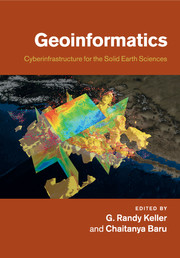Book contents
- Frontmatter
- Contents
- List of contributors
- Preface
- Introduction
- Part I Case studies from other disciplines
- Part II Modeling software and community codes
- Part III Visualization and data representation
- Part IV Knowledge management and data integration
- Part V Web services and scientific workflows
- 12 Service orientation in the design of a community hydrologic information system
- 13 Web services for seismic data archives
- 14 Development of robust data system for gravity and magnetic anomaly data: A case study of a community-based effort for point data
- 15 Scientific workflows for the geosciences: An emerging approach to building integrated data analysis systems
- 16 Online access and processing of LiDAR topography data
- 17 Use of abstraction to support geoscientists' understanding and production of scientific artifacts
- Part VI Emerging international and other efforts
- Index
- Plate section
- References
12 - Service orientation in the design of a community hydrologic information system
from Part V - Web services and scientific workflows
Published online by Cambridge University Press: 25 October 2011
- Frontmatter
- Contents
- List of contributors
- Preface
- Introduction
- Part I Case studies from other disciplines
- Part II Modeling software and community codes
- Part III Visualization and data representation
- Part IV Knowledge management and data integration
- Part V Web services and scientific workflows
- 12 Service orientation in the design of a community hydrologic information system
- 13 Web services for seismic data archives
- 14 Development of robust data system for gravity and magnetic anomaly data: A case study of a community-based effort for point data
- 15 Scientific workflows for the geosciences: An emerging approach to building integrated data analysis systems
- 16 Online access and processing of LiDAR topography data
- 17 Use of abstraction to support geoscientists' understanding and production of scientific artifacts
- Part VI Emerging international and other efforts
- Index
- Plate section
- References
Summary
Introduction
Hydrology is an observational science concerned with the motion of the water through the hydrologic cycle. The Committee on Opportunities in the Hydrologic Sciences (1991, p. 43) defined hydrology in this way: “Hydrology is the science that treats the waters of the Earth, their occurrence, circulation, and distribution, their chemical and physical properties, and their reaction with their environment, including their relation with living things.” Bearing in mind the vast extent of the waters of the Earth, their ceaseless motion, the existence of water as ice, liquid, and water vapor, and the global distribution of water throughout the atmosphere, land surface, and subsurface, hydrologic science is complex. Constructing a comprehensive picture of its phenomena involves the assembly of data from many sources, both organizations and individual researchers. The Committee on Opportunities in the Hydrologic Sciences (1991, p. 265) stated further that “Advances in the hydrologic sciences depend on how well investigators can integrate reliable, large-scale, long-term datasets.”
Observation of hydrologic phenomena can be by direct sensing, or by remote sensing, depending on whether the measurement of water properties is made by a gage or water sample directly from a water body, or whether the water property is inferred from a camera or sensor measuring reflected or emitted radiation at a distance from the water body. Directly sensed observations from rainfall or streamflow gages are expressed as time series, in which a regular sequence of data values is indexed by the measurement time, and georeferenced by the latitude and longitude of the sampling site.
- Type
- Chapter
- Information
- GeoinformaticsCyberinfrastructure for the Solid Earth Sciences, pp. 193 - 209Publisher: Cambridge University PressPrint publication year: 2011
References
- 1
- Cited by



